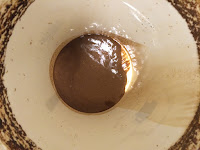 |
| Cider and transfer-to carboy |
The cider fermentation was both literally and figurative ALIVE! A foam would form on top and then dissipate and then reform, and the bubbler was active with a lot of CO2 off-gassing. The turbid cider gradually clarified as the yeast flocculated ending with a significant yeast cake at the bottom of the carboy and clearer liquid. I was pretty surprised at how dry it was when I taste-tested a little. It had a nice nose and good apple flavor but no sweetness. I will try to "add-back" a little of the sugar to provide a little sweetness after this secondary fermentation.
The second brew that I racked over was a vanilla-bourbon stout. I had purchased the kit more than a year ago. I had also purchased the yeast when I purchased the kit. I had set out to start this kit in September, but when I started the yeast, it wasn't viable (it had gone through a year of abuse in our refrigerator). I am glad that I started with a yeast starter, because if I hadn't, I wouldn't have known the yeast was dead. I would have wasted an entire batch. Take-two of launching this brew went better (after I purchased a second yeast packet). The malt (sugar content) of this brew is higher than I have ever tried before. The kit included a lot of dark malts to steep, a pound of oatmeal, two packages of malt extract and corn sugar that was added to the wort.
 |
| Stout yeast-cake |
Brewing went pretty well, but it took about 6-7 hours (including clean up). I pitched the yeast on a Sunday three weeks ago. It took off nicely with some vigorous CO2 evolution, but after a week the rate was already slowing. I left it in the primary fermenter for three weeks, but I was a little worried that the fermentation had stalled out. I was really happy to see a significant yeast cake when I racked this brew over to the secondary fermenter carboy.
 |
| Brews in their secondary fermenters |
No comments:
Post a Comment